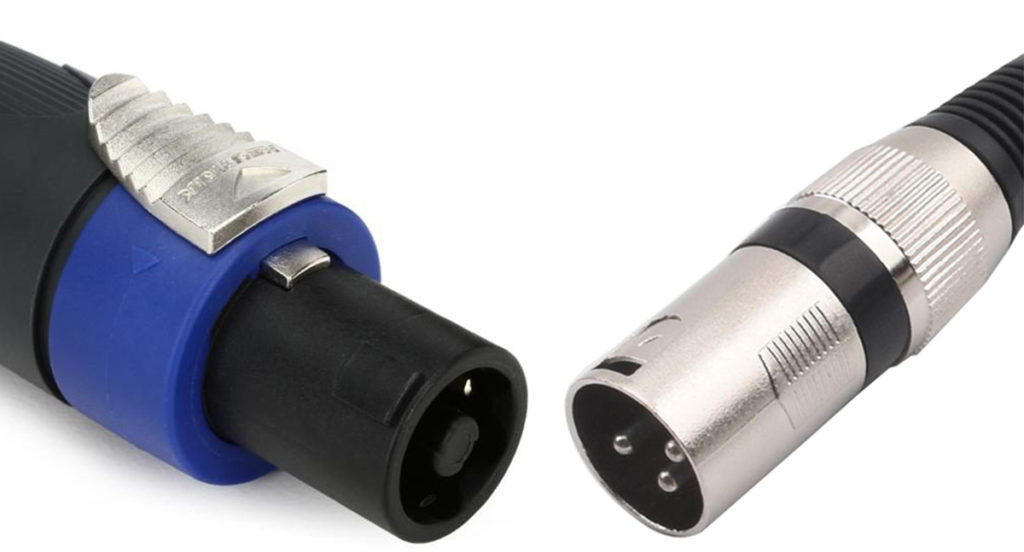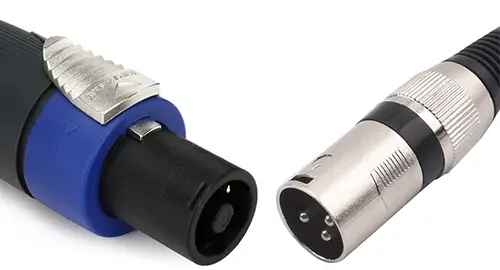Speakon and XLR are two of the most common types of audio cable connectors. Have you ever wondered whether they’re the same or are there any differences?
Speakon and XLR connectors are not the same, although both are used to carry audio signals. XLR accepts cables that carry a max of 15-amps and are typically used for microphones and line-level signals. Speakon connectors, which connect power amps to loudspeakers, accept cables that carry up to 50-amps.
Using the correct type of cable in your rig is a must. So, the rest of this article is dedicated to further explaining the differences between Speakon and XLR cable connectors and answering some of the most commonly asked questions related to them.

The Difference Between Speakon and XLR Connectors
The main difference between Speakon and XLR connectors is the power they can handle. Speakon connectors are designed to connect power amps to loudspeakers and can carry up to 50-amps. XLR connectors, on the other hand, are typically used for microphones and line-level signals and can only carry a max of 15-amps.
Another difference between the two is that Speakon connectors have twisting locking mechanisms to keep them secure, while XLR connectors have only a push-button lock. This is important to note if you’re using high-powered equipment, as an XLR connector could come loose and cause a short circuit. This is quite rare, however.
Finally, Speakon connectors are available in 2-pole, 4-pole, 6-pole, and 8-pole variations, while XLR connectors are only available in 3-pole versions. One is used for ground, while the other two wires carry the signal but with reverse polarity. This is what creates a balanced signal. SpeakOn is not balanced, which is why it only requires two wires.
What is an XLR Connector?
XLR connectors are a type of audio cable connector that is typically used for microphones and line-level signals. They can carry a maximum of 15-amps and are available only in one configuration.
XLR connectors are usually found on professional audio equipment, such as mixing consoles and PA systems. They’re also common on microphones, as they allow the mic to be powered by an external source for when phantom power is required.
Also, microphones and stringed instruments typically have low voltage output, so it’s good to use a balanced cable when possible.
XLR connectors (short for External Line Return) are more commonly used for connecting smaller audio devices such as microphones, amps, and soundboards. Used in both live and studio applications, XLR is another one of the industry standards.
XLR cables carry a line-level signal and are typically used to connect microphones to the soundboard. However, audio engineers regularly use them to connect audio to active (powered) speakers, as they do not require the power to come from the cable.
What is a Speakon Connector?
Speakon connectors are a type of audio cable connector that is used to connect power amps to loudspeakers. They can carry up to 50-amps and are available in 2-pole, 4-pole, 6-pole, and 8-pole versions.
Each pair can drive a single speaker, so at most, the 8-pole SpeakOn connector can drive four speakers.
Speakon connectors are designed for use with high-powered equipment and, as such, have locking mechanisms to keep them secure. This is important to note if you’re using high-powered equipment, as an XLR connector could come loose and cause an electrical hazard.
Due to their ability to handle the stress of an extensive PA system, Speakon connectors have become an industry standard for gigs and concerts of any size.
Are There Any Adapters to Connect Speakon to XLR?
Yes, there are adapters that allow you to connect Speakon to XLR. However, we don’t recommend using them when driving loudspeakers.
The main reason is that Speakon connectors are designed to carry up to 50-amps, while XLR connectors can only carry 15-amps. So, if you’re using an adapter to connect Speakon to XLR, you’re potentially creating a fire hazard when sending a lot of power through them.
The Advantages of Speakon Connectors
Here are some of the advantages of using a SpeakOn connector and cable:
Higher Power Transfer
The most significant benefit of running a system with Speakon cables and connectors is the superior ability to transfer the power from the power amplifier to the speakers.
Speakon connectors were designed to accept thicker wires into the connector. This design advantage is why they are more adapted for speaker connections than their XLR counterparts.
On the other hand, XLR connectors can only accept wires that are thinner. The difference in thickness is one reason why Speakon has a higher power rating.
The thicker the wire, the more current can flow through it without getting too hot. Imagine a garden hose versus a fire hose. The bigger hose can deliver a lot more water, right?
Easy To Make on Your Own
Both building and fixing Speakon-equipped cables is an easy process. Anyone that knows how to use a wire stripper can buy a SpeakOn connector and a cable and build their own SpeakOn cable.
What makes Speakon cables so easy to build?
Speakon connectors contain screw terminals inside their housing. So whether you need to set or re-set the wires, all you’ll need is a screwdriver and wire strippers.
Check out this video to see how to wire a SpeakOn connector:
XLR cable building is similar but different and more challenging, as building or repairing a typical microphone cable requires a soldering iron, which takes both more effort and knowledge.
Check out this video to see how to wire an XLR connector:
More Durable
If you decide not to build your own Speakon cables and purchase a premade one, you’ll save yourself a few minutes.
Speakon cables are known for their quality and ruggedness.
Flexible construction, aided by the use of quality materials, is responsible for the sturdiness of SpeakOn connectors and cables. Innovative solutions, such as the collar that prevents the line from excessive twisting near the connectors, only further help SpeakOn connectors last longer.
Solid Locking Mechanism
When used on the stage, one of the main advantages of connecting your PA system and speakers using SpeakOn cables is the locking mechanism that comes with these connectors.
A simple twist and turn mechanism ensures that no one can unplug your cables by accident.
Standard XLR connectors also have a locking feature, but it’s not as effective as the one on SpeakOn connectors.
The Advantages of XLR Connector
Here are some of the advantages of using an XLR connector and cable:
Balanced Audio Signal
As we’re all aware, most XLR cables come with three pins, which serve as positive, negative, and ground connections. The positive and negative pins transfer the same audio signal but with different polarities.
Because of the inverted polarity, XLR cables carry balanced audio signals. This leaves us with two questions:
- What’s the ground wire for?
- What are the benefits of balanced audio?
Both of these questions share one answer: The ground wire wraps around the signal wires, acting as a shield from any potential interference. The final result is a noise-free audio signal that you can’t get with unbalanced cables.
Speakon cables are not balanced, but the noise that the cable picks up on the way to a speaker is negligible since the signal has already been amplified.
More Affordable
We’ve previously learned that XLR cables use thinner cables compared to those used for SpeakOn cables. While these cables can’t handle the same amount of current as Speakon cables, they come with one major benefit.
Generally speaking, XLR cables are significantly less expensive than SpeakOn cables. Less copper means that it costs less to make the cable.
Can You Plug XLR Into Speakon?
We’ve already established that Speakon and XLR cables are built for different purposes. But what happens when you have a speaker with a SpeakOn connection and an XLR cable? Can You Plug XLR Into Speakon? And Vice Versa?
You can plug XLR into Speakon using an XLR to SpeakOn adapter. There are also SpeakOn to XLR adapters, but the user must be careful not to overpower the XLR connection since SpeakOn cables are designed to deliver more power than XLR.
You should pay attention to the type of cable you’re using. When connecting an amp to a non-powered speaker, you must use a speaker cable instead of a microphone cable that typically comes with an XLR connection.
One solution could be to use a cable with a SpedakOn connector on one end and an XLR connector on the other end. This Speakon to XLR cable on Amazon would work great.
It’s a 25ft long cable, which is long enough to fit most needs. It’s suitable for short cable runs from your power amplifier to your speakers but can’t deliver too much power because it has a wire thickness of 16 gauge.
For reference, SpeakOn cables recommend 12 gauge or bigger.
Conclusion
Speakon connectors are known for their quality and ruggedness, while XLR connectors offer a number of advantages, such as a balanced audio signal.
Although Speakon cables are not balanced, they are still a better option than unbalanced cables because they handle more current. XLR cables are less expensive than SpeakOn cables, making them a more budget-friendly option. You can plug an XLR cable into a Speakon port using an adapter.
When making the decision between Speakon and XLR cables, it is important to consider the purpose of the cable and the equipment that it will be used with.
While Speakon connectors are better for high-power signals, XLR cables are the way to go when connecting microphones, guitars, and other line-level devices and instruments.

